What are Kalash (COCONUT POT) Facts (Meaning, Importance, Significance, History) in Hinduism | Why is Kalash on top of temple?
Namaste friends, how are you doing today? Welcome to #BhagavanBhakthi website / blog.
Bhagavan Lord Sri Vishnu (Krishna, Rama, Trivikrama, Narasimha, Vamana, Vasudeva, Mukunda) and Goddess Lakshmi (Rukmini, Satyabhama, Sita, Kamala, Maya) blessings to you and your family!
In this website / blog, you will always learn about #Hinduism #Sanskrit language.
Also subscribe to my YouTube channel from this link #BhagavanBhakthi to view videos about #Hinduism #Sanskrit language.
Just before going to “What are Kalash (COCONUT POT) Facts (Meaning, Importance, Significance, History) in Hinduism | Why is Kalash on top of temple?“, let us have a brief some brief information.
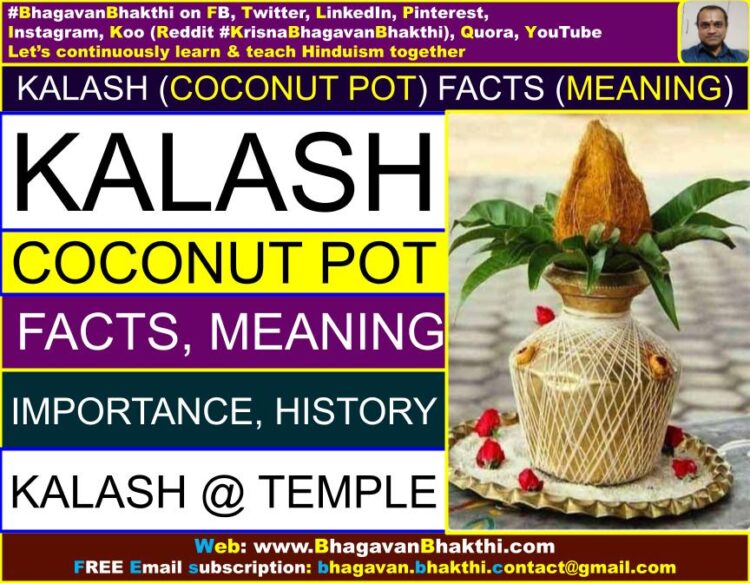
Hinduism (Sanatana Dharma) is so wide and extensive, it knows all the ingredients that are required for well-being, both materially and spiritually.
Hindus know how to use a plant (tree), it’s leaves, stems, fruits, roots, etc. in multiple occasions, that is, during worship (pooja), functions, rituals, ceremonies, to prepare food, etc.
It may be a tiny plant or a huge tree, Hindus are well-versed on how to use it both materially and spiritually.
Now, let us learn about one of the most auspicious tree’s fruit in Hinduism called ‘Coconut’. In Sanskrit Coconut is known as ‘नारिकेल / ನಾರಿಕೇಲ / nārikēla’.
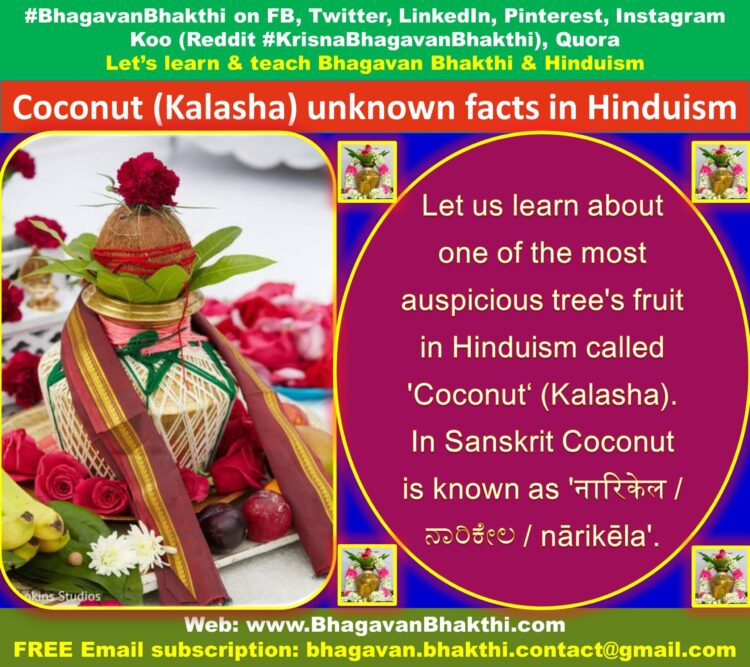
What are Coconut (Kalasha / Kalash) facts in Hinduism are as given below:
1. Pooja : In Hinduism (Sanatana Dharma), one of the most common offerings during a pooja (worship) in house or in a temple is a coconut.
2. Other auspicious occasions : We should also note that, coconut is also offered (used) on occasions like weddings, festivals, rituals, ceremonies, to do pooja when a new vehicle is bought, to do bhumi pooja just before the construction of house or building or bridge etc.
3. Kalasha : A ‘kalasha’ (Also spelled as Kalash) is a divine pot full of water, adorned with mango leaves and a coconut on top is worshipped on important occasions and used to receive revered guests.
4. Yagna : A coconut is offered in the yagna (sacrificial fire) whilst performing homa.
5. Breaking of coconut : One or more coconut(s) is / are broken and placed before the Bhagavan photo or deity.
6. Coconut as Prasadam : Coconut is thus later distributed as prasadam to one and all.
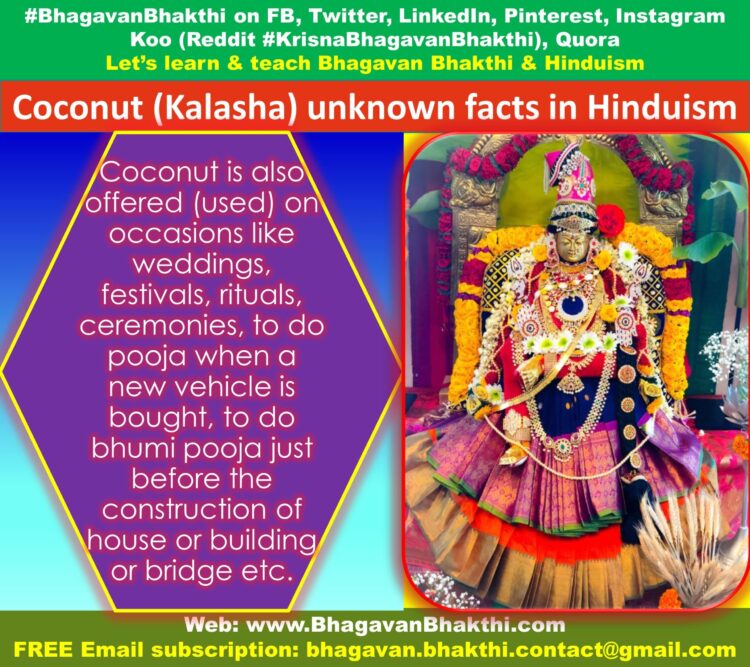
7. Neivedya : Coconut is offered as ‘neiveday’ (divine food) to please Bhagavan or to fulfill our material and spiritual desires.
8. Before offering : Just before the offering, the coconut’s fiber covering of the dried coconut is removed except for a tuft on the top.
9. Coconut looks like a human face : The marks on the coconut make it look like the head / face of a human being.
10. Ahankaram : Later the coconut is broken, symbolizing the breaking of the ‘ahankaram’ (haughtiness / ego / pride / passion / arrogancy etc.).
11. Vasana : The water or juice within the coconut shell represents the inner tendencies (vasanas / वासन / ವಾಸನ / vāsana) is offered along with the white kernel (the mind), to Bhagavan.
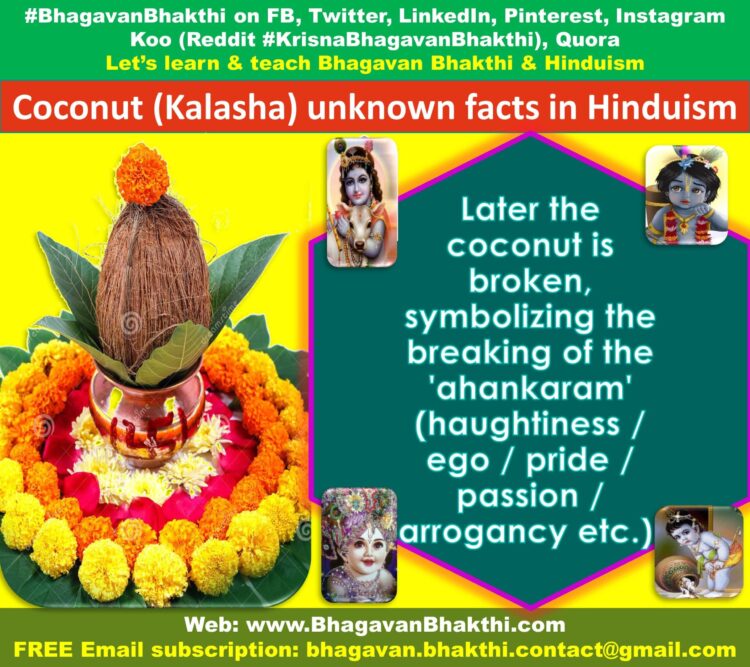
12. Purification : A mind thus purified by the touch of Bhagavan is used as prasadam (a holy food).
13. Abhishekam : In the spiritual and traditional ‘abhishekam’ (divine pouring) ritual done in all temples and many homes, several materials are poured over the deity like milk, curd, honey, tender coconut water, sandal paste, holy ash etc.
14. Specific significance : Here each of the above material has a specific significance of bestowing certain benefits on worshippers.
15. Spiritual growth : The tender coconut water is used in abhishekam rituals will bestow spiritual growth on the seeker.
16. Generous service : A coconut also represents generous service, that is, every part of the coconut tree starting from the trunk, leaves, fruit, coir etc. is used in innumerable ways, for example thatches, mats, tasty dishes, oil, soap etc.
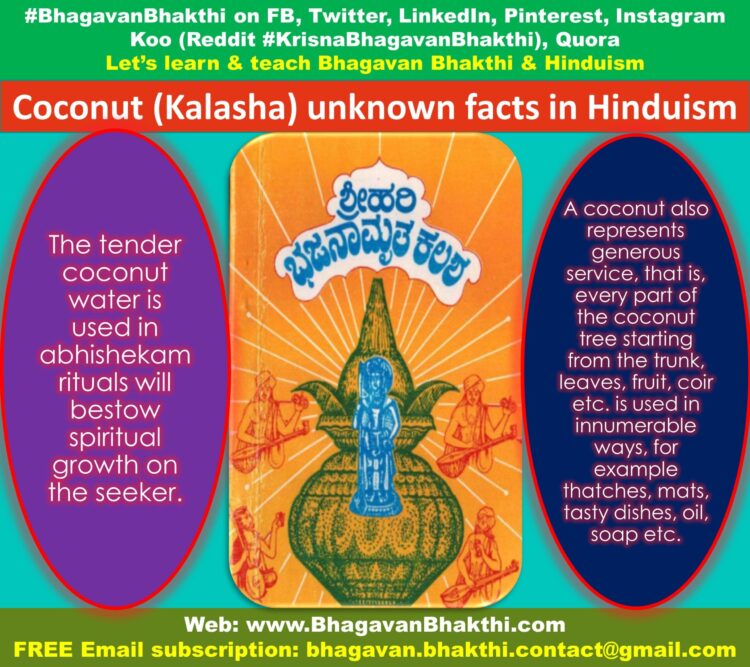
17. Salty water into sweet water : A coconut tree takes in even salty water from the earth and converts it into sweet nutritive water that is especially beneficial to sick people. This is the greatness of a coconut tree and it’s different parts.
18. Ayurvedic medicines : A coconut is also used in the preparation of many ‘ayurvedic aushadis’ (आयुर्वेदिक औषधि / ಆಯುರ್ವೇದಿಕ ಔಷಧಿ / āyurvēdika auṣadhi / medicines) and in other alternative medicinal systems also.
19. Three eyed Lord Shiva : The marks on the coconut also symbolizes the ‘three-eyed Lord Shiva’ and thus it is considered to be a means to fulfill our desires.
20. Knowledgeable person : In certain divine ceremonies, a coconut is placed on a kalasha, decorated, garlanded and worshipped as symbolic of Lord Shiva and of the ‘man of realization’ (ज्ञानि / ಜ್ಞಾನಿ / jñāni / gnani / knowledgeable person).
21. Satyanarayana pooja : During Sri Satyanarayana pooja also, coconut is used as a Kalasha in front of the Sri Satyanarayana photo or deity.
22. Worship : A Purna Kalasha (Purna Kumbha) is worshipped in all Hindu festivities related to marriage and childbirth, as a mother goddess or Devi.
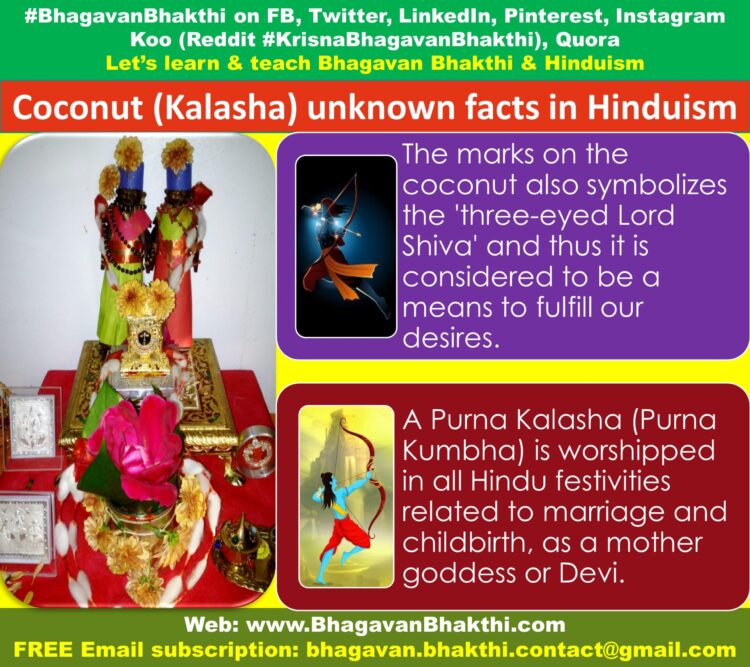
Why do we worship a Kalasha? – (First of all, let us know what is a Kalasha?)
“It is a brass, gold, silver, mud or copper pot is filled with water. On this, mango leaves are placed at the mouth of the pot and a coconut is placed over it.”
“A red or white thread is tied around its neck or sometimes all around it in an intricate diamond-shaped pattern. The pot may be decorated with designs.” Such a pot is known as a ‘Kalasha’.
When the pot is filled with water or rice, it is known as ‘पूर्ण कुंभ / ಪೂರ್ಣ ಕುಂಭ / pūrṇa kumbha / purna kumbha’ representing the inert body which when filled with the divine life force gains the power to do all the wonderful things that makes life what it is.
A Kalasha is placed with due rituals on all-important occasions like the traditional house warming (gruha pravesha), wedding, daily worship, etc. A Kalasha is placed near the entrance as a sign of welcome.
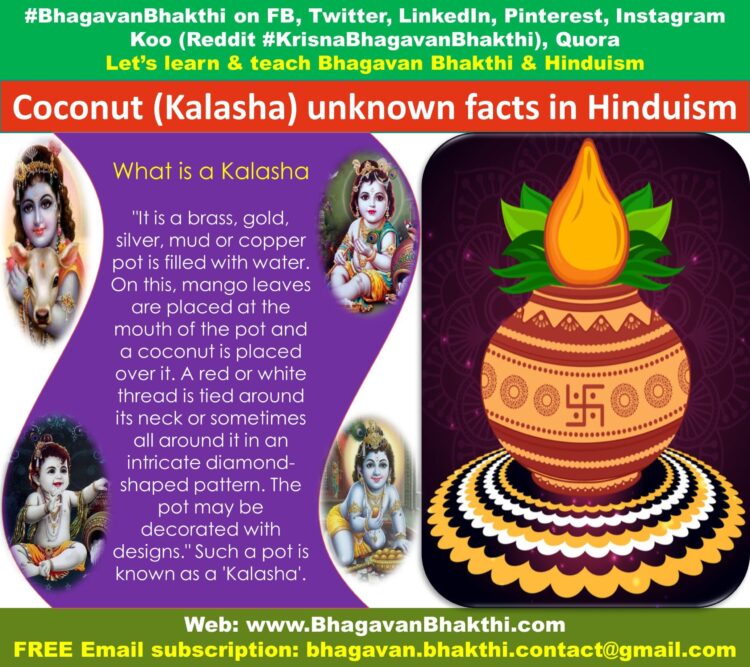
A Kalasha is also used in a traditional manner while receiving holy personalities.
[Before the creation came into being, Bhagavan Sri Vishnu was reclining on His snake-bed (Thus he is known as Shesha Shayi or Shesha Shayana) in the milky ocean (Kshirasagaram).]
[From His navel (nabhi) emerged a lotus (kamala) from which appeared Sri Brahma Deva, the Creator of the universe, who thereafter created the whole universe as per the instructions of Bhagavan Sri Vishnu.
[Since Sri Brahma Deva is born from the nabhi (navel) of Bhagavan Sri Vishnu and will be sitting on a padma (lotus flower), Bhagavan Sri Vishnu is known as Sri Padmanabha].
The water in the Kalasha symbolizes the primordial water from which the entire creation emerged.
This divine water of Kalsha, is the provider of life to one and all, and also has the capabilities of creating unlimited names and forms, the inert objects and the sentient beings and all that is auspicious in the cosmos from the energy behind the universe.
Kalash’s parts and it’s significance is as given below:
1. The Kalasha’s leaves and coconut represent creation. | 2. The thread represents the love that “binds” all in creation. |
3. A Purna Kalasha (Purna Kumbha) is a symbol of auspiciousness embodying either Ganesha, remover of obstacles, or his mother Gauri, the goddess of household bounty or Sri Maha Lakshmi Devi. |
4. A Kalasha represents material things, that is, of fertility – the earth and the womb, which fosters and nourishes life. |
5. The mango leaves is associated with Kama, the god of love, symbolize the pleasure aspect of fertility. |
6. The coconut represents prosperity and power. | 7. The water in the pot represents the life-giving ability of Nature (Amrita). |
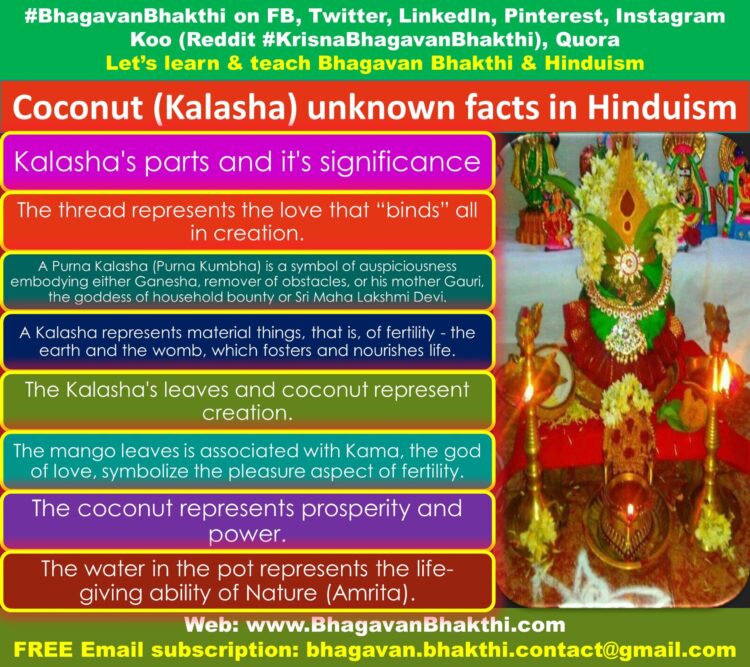
Thus a Kalasha is therefore considered highly auspicious and therefore worshipped in all the Hindu festivals (ceremonies and rituals).
The waters from all the holy rivers (E.g., Ganga, Yamuna, Saraswati, Godavari, Narmada, Sindhu, Kaveri, etc.) is the knowledge of all the Vedas and the blessings of all the deities are invoked in the Kalasha.
Thus the water is thereafter used for all the rituals, including the abhishekam (The consecration / Kumbha abhishekam) of a temple deity is done in a grand manner with elaborate rituals including the pouring of one or more Kalashas of holy water on the deity.
[When the asuras (Demons) and the Devatas (Demigods) churned the Kshira Sagaram (Milky ocean), Bhagavan Sri Vishnu appeared bearing the ‘pot of nectar’ (Amrita Kalasha), which blessed one with everlasting life.]
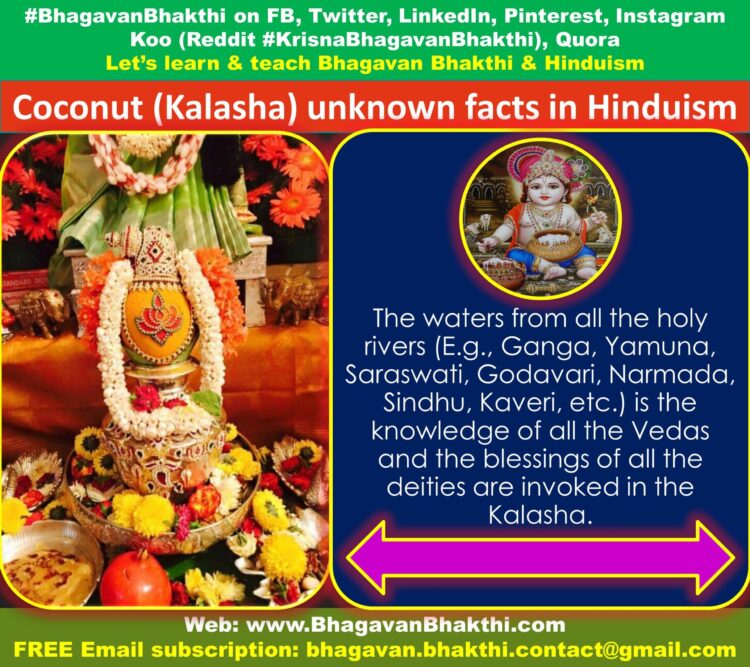
For this reason, the Kalasha also symbolizes immortality (Chiranjeevi / Very very Long life). Men of high wisdom are full and complete, as they identify with the infinite Truth (poornatvam).
These men of high wisdom brim with joy and love and represent all that is auspicious. Thus, we usually greet them with a ‘Purna Kumbha’ (Full pot) acknowledging their eminence and as a sign of respectful and reverential welcome them with “whole heartedly”.
Scientific importance of coconut (Kalash) is as given below:
Time was when tender coconut was only a natural thirst quencher in summer. But, nowadays whole world knows it as a drink for health and vitality.
1. Coconut water is a regular drink for those who want to place their health in a premium position.
2. The busy professionals always on the move and up to the homemakers who want to meet the nutritional requirements of entire family drink coconut water on regular basis.
3. In fact, the tender coconut water is quintessentially natural, a welcome break from fizzy artificial energy drinks in the market.
4. The tender coconut gives us a daily dose of vital nutrients to keep our body energized and feeling really good.
5. Even the soft pulp in tender coconut is the ‘food of the Gods’.
6. The soft pulp has a divine taste and is packed with vitamins and minerals not to be missed after your tender coconut water drink.
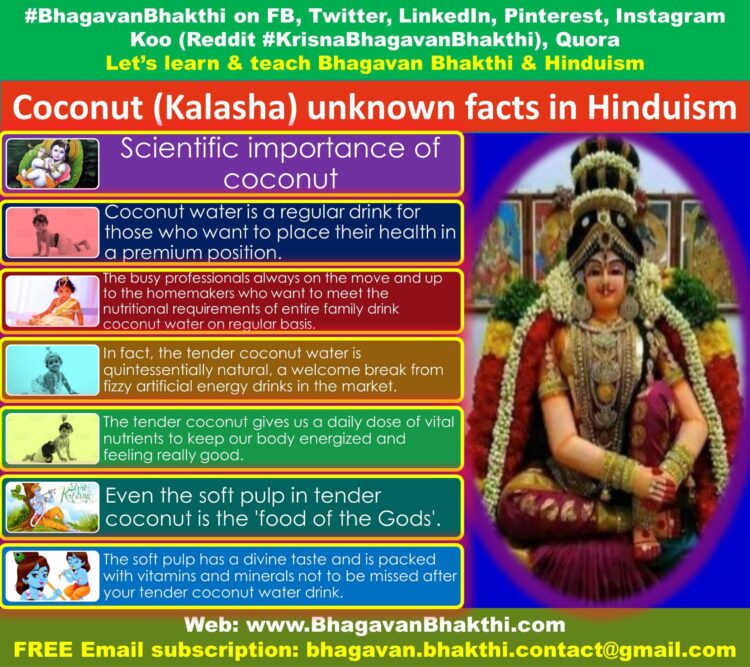
Nutritional properties of coconut is as given below:
1. The fluid’s caloric value is 17.4 per 100 g. The major chemical constituents of coconut water are reducing sugars (4.4%) in the forms of glucose and fructose.
2. Coconut also contains essential minerals such as phosphorous, iron, potassium, sodium, calcium, magnesium, copper etc.
3. The tender coconut water being rich in potassium and other minerals is a natural energizer.
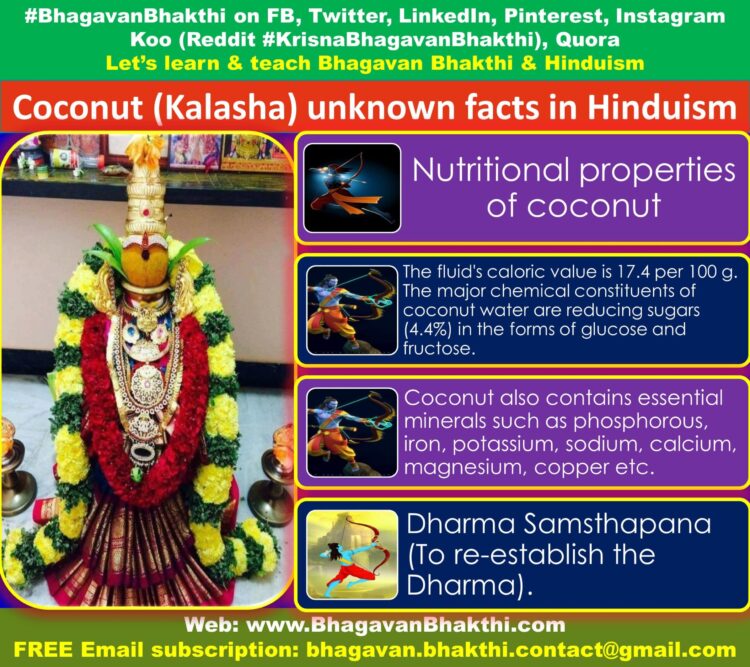
More reasons to drink Coconut water is as given below:
Coconut water is full of medicinal values and this is been said very clearly in Ayurveda also. We Hindus (Sanatana Dharmis) know about this since unknown time.
Below given are the reasons why we should drink coconut water on regular basis:
1. An instant refresher, no matter where you are. | 2. It has natural sugars and flavors instead of processed sugars like other drinks.
3. It’s 100% natural. | 4. Bottled by nature and carries zero additives. | 5. A health tonic packed with vitamins, minerals, etc.
6. Has very low sodium than other sports and energy drinks and thus ensures less heart problems and dehydration. | 7. Has lesser fat than milk. |
8. It is healthier than a fruit drink and also work wonders for cooling your whole body. | 9. Contains more potassium than most energy and sports drinks. | 10. Has zero cholesterol.
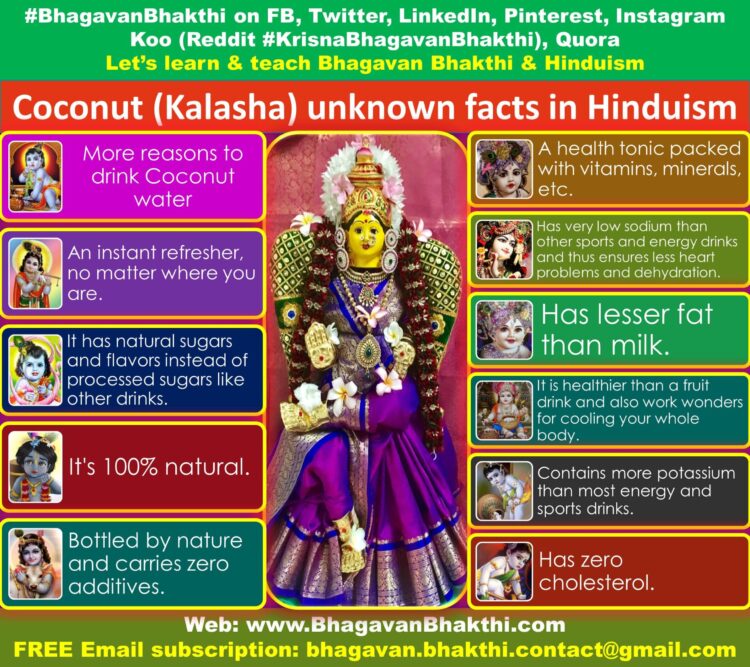
Do you know this? – During the World War II in the Pacific Ocean, coconut water siphoned directly from the nut was used regularly to give emergency plasma transfusions to wounded soldiers.
This is the greatness of mother earth and nature which has provided us one of the greatness gifts of nature called “coconut water”.
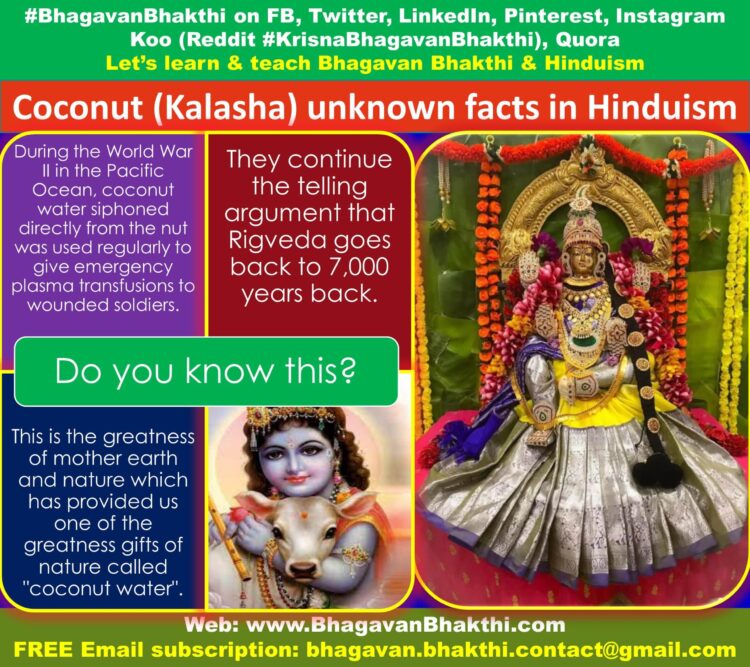
More information will be added to this on regular basis. Please this post and other posts of this website / blog to get the updated information.
Know more about Hinduism and Sanatana Dharma : Hinduism (Sanatana Dharma) on Bhagavan Bhakthi website
Dear friends, if you need any clarifications about this post, kindly let me know, I will definitely try to answer all of them.
Also your one LIKE, one COMMENT, One Share, one SUBSCRIPTION is highly important.
This will help to know the quality of this content and also it will be helpful to know if any improvements is required for the content.
If you feel this content is useful to you and has helped you to improve your knowledge, kindly share this with your well-wishers.
Because “SHARING MEANS CARING”.
For receive FREE EMAIL SUBSCRIPTION about #BhagavanBhakthi, you can send an email to bhagavan.bhakthi.contact@gmail.com from your email ID.
NAMASTE!
SRI GURUBHYO NAMAHA
OM NAMO NARAYANAYA
Sri Krishnaarpanamastu
Share in Social Media